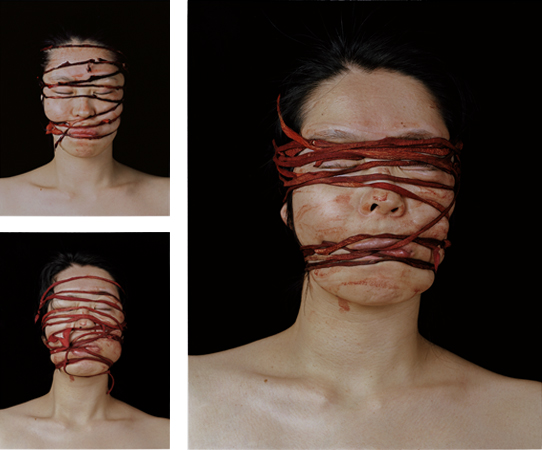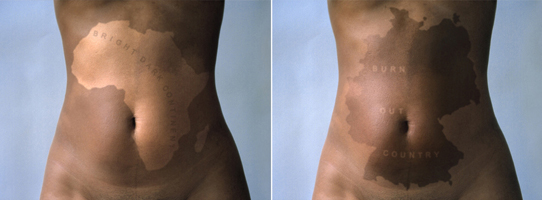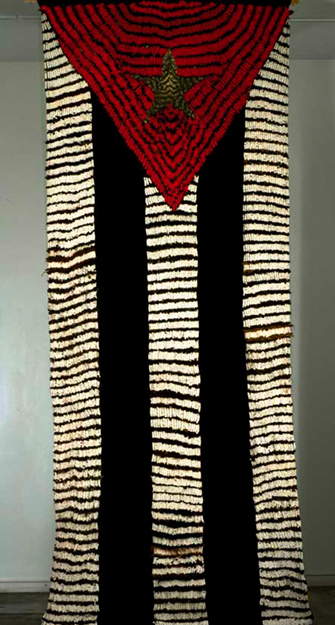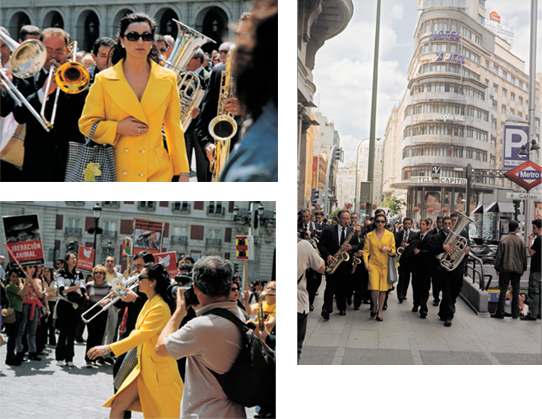
Boryana Rossa (Bulgarian, b. 1972). Celebrating the Next Twinkling (Praznuvane na sledvascia mig), 1999. Single-channel video, Edition of 2, 2 min. 45 sec. Private collection. Photograph courtesy of the artist

Boryana Rossa (Bulgarian, b. 1972). Celebrating the Next Twinkling (Praznuvane na sledvascia mig), 1999. Single-channel video, Edition of 2, 2 min. 45 sec. Private collection. Photograph courtesy of the artist

Ryoko Suzuki (Japanese, b. 1970). Bind, 2001. Lambda print. Tokyo Metropolitan Museum of Photography. (Photo: Courtesy of Zeit-Foto Salon, Tokyo)
In her Bind series, Ryoko Suzuki wraps her head with tightly wound pigskin that has been soaked in blood. The pigskin refers to the artist’s childhood memories, specifically of an English fairytale, Three Little Pigs, written by Joseph Jacobs. Blood symbolizes female sexuality and the artist’s poignant transition from adolescence to womanhood. As the skin is tightly wrapped around her head, her features become warped, almost unrecognizable. Within the Emotions section of the exhibition, Bind stands as a symbol for pain, constriction, and the abject female body.
The idea of “pig is cute” was implanted in me by adults through a cartoon, the “Three Little Pigs.” However, breeding pigs I saw at a pig farm, when I was a child, were so huge and ferocious that I could never find any cuteness in them. That was the first time I realized that the fairytale world was far from the reality, and I felt betrayed by adults. That is why I employ the “Three Little Pigs” as a symbol of lies and fictions given by adults, which become exposed sooner or later in the process of a child’s growth. The “Bind” series expresses my inner self; a grown-up who left the world given by my parents and other adults and acquired my own thinking, and a woman who has to deal with the female sexuality. In the series, I bound myself with pigskin, which has been soaked in blood as a symbol of womanhood, as a symbol of the given world. I was thinking of my life, in which I had transformed from a child who just took what adults provided, to a woman who led her own life, while I wrapped up my eyes, nose, mouth, and ears with the pigskin. The series is a record of this action. —Ryoko Suzuki

Ingrid Mwangi (Kenyan, b. 1975). Static Drift, 2001. Two chromogenic prints mounted on aluminum, edition of 5. Heather and Tony Podesta Collection, Falls Church, Virginia. (Photo: Courtesy of Galerie Anne de Villepoix, Paris)
In the photographic series Static Drift, Ingrid Mwangi experiments with her own body, likening it to an open book upon which her own national and racial lineage is both written and read. Here the artist transposes the borderlines of Germany and Africa onto her stomach by way of a stencil and exposure to the sun. National titles and geographic borders are displaced from their habitual contexts, causing one to contemplate what nationalism, skin color, and ethnic identity mean when physically inscribed on a body—particularly a female body. Within the dichotomy of Mwangi’s personal biography (she was born in Nairobi and has lived in Germany for many years), the historical relationship between Germany and Africa, colonizer and colonized, oppressor and the oppressed, is also powerfully evoked.

Tania Bruguera (Cuban, b. 1968). Statistic (Estadistica), 1996. Textile, human hair of anonymous Cubans, thread, and fabric. Private collection, New York
From the Memoria de la postguerra series, Estadistica was fabricated from human hair collected from residents of Cuba. During a five-month collaborative project, Bruguera worked with artists and citizens from all over the island who contributed their hair and assisted in the rolling or sewing of the work. After being rolled into cloth strips, the hair was then attached to the work’s support structure. The textile is suggestive of the Cuban flag in its design and recalls the mourning flags flown outside homes on the island. Its technique of fabrication recalls the role of women during the Cuban war of independence (1868–78), when they sewed what was at the time a flag of liberation.
At the same time, Estadistica also represents Bruguera’s exploration of the mass exodus of Cubans to the United States in the 1980s. Of this she says: “What we were left with looked like a landscape of trenches devastated by war, in which many of us who remained were exhausted, beaten, or disillusioned and changed our outlook or picked ourselves up in a more personal, private way.” According to Bruguera, each clump of hair in the work symbolizes an individual’s state of being and contains a portion of their willpower and internal energy. In this manner, Estadistica stands as a powerful symbol of nationalism woven out of the collective daily existence of ordinary people.

Pilar Albarracín (Spanish, b. 1968). Long Live Spain (Viva España), 2004. Production stills; video, 3 min. 30 sec., color, stereo sound. Lent by the artist. © Pilar Albarracín. (Photo: Courtesy of the artist)

Global Feminisms
March 23–July 1, 2007
In celebration of the opening of the Elizabeth A. Sackler Center for Feminist Art, the Museum presents Global Feminisms, the first international exhibition exclusively dedicated to feminist art from 1990 to the present. The show consists of work by approximately eighty women artists from around the world and includes work in all media—painting, sculpture, photography, film, video, installation, and performance. Its goal is not only to showcase a large sampling of contemporary feminist art from a global perspective but also to move beyond the specifically Western brand of feminism that has been perceived as the dominant voice of feminist and artistic practice since the early 1970s.This exhibition is arranged thematically and features the work of important emerging and mid-career artists.
The Brooklyn Museum presents exhibitions that give voice to diverse points of view. Global Feminisms contains challenging subject matter that some visitors may find disturbing or offensive. Children 17 and under must be accompanied by an adult. Discretion is advised.
This exhibition is co-curated by Maura Reilly, Ph.D., Curator of the Elizabeth A. Sackler Center for Feminist Art, Brooklyn Museum, and Linda Nochlin, Ph.D., Lila Acheson Wallace Professor of Modern Art, Institute of Fine Arts, New York University.
Global Feminisms is sponsored by Altria Group. Additional support is provided by the Elizabeth A. Sackler Foundation and the French Embassy Cultural Services.


